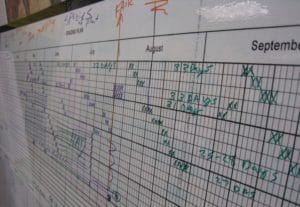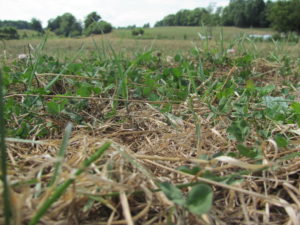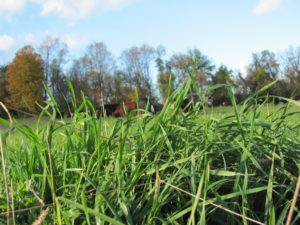A Four Dollar Grazing Chart
My farm teetered between a D1 and D2 (Moderate to severe) on the U. S. drought monitor scale most of last summer which tested my 26 years of grazing experience and thinking skills. Although I must admit to being up for the challenge, at times it was a highly stressful endeavor to manage a newly started organic dairy heifer custom grazing business model without much snow or rain. Surprisingly, what saved me during this trying time was a 4 dollar grazing planning chart hung on my office door.
I know what you’re thinking; a piece of paper (and not money) is credited with getting a farmer through the grazing season. Yep, but let me elaborate a bit. This change of managing through using better decision making tools has been a long time in the making. It has come about at my own expense, literally, as I dropped some coin to attend holistic management grazing planning workshops and to travel around visiting other successful graziers throughout the country. I also say expense because I have missed so many opportunities to manage grass more effectively but my pride, lack of monitoring and keeping records kept me in observational mode instead of being a strategic grazier.
On a trip to Missouri visiting Greg Judy’s farm the light really clicked for me. As the “microbe messiah” was showing me all the exciting things he was doing on the farm and quoting day’s recovery periods and such, I finally told him to stop yacking and show me how he makes decisions in grazing management. After the shock, he ushered me into his office where his wall was covered with 3 years of planned grazing charts like a military war room. He knew where he was, where he was going and where he had been all in a cohesive chart complete with paddocks, rest periods, weather info, animal dry matter calculations and major events identified like vacations, calving, breeding and stockpiling. It’s exactly what I needed. At that moment I thought, I’ve got to get busy with this kind of management instead of always chasing grass or worse, losing money.
This led me to Allan Savory’s Holistic Management Handbook with associated grazing charts but like many farmers, I had to tweak the chart to fit my needs and environment. At first I used it mostly as a visual diary of how long I was in a paddock but after the first rotation, curiosity had me planning ahead a week, then a month, then several months – all in pencil of course because we all know grazing plans are always in flux. With practice and feedback from other farmers who were also trying the tool we refined the chart down to its simplest form through a Northeast SARE ‘Professional Development Project’ grazing training grant. Now with three years of planned grazing management monitoring under my belt, the true test was about to happen amidst the 2012 weather freakshow.
Invaluable in this process is that you need to know what you’re managing towards, know your paddocks and acreages, know your forage and animal needs and know your financial picture. To sum it up, you need a whole farm conservation plan before you can use this tool effectively. In my case I also have a nutrient management plan that tells me where to focus fertility for improved soil health. The hard part is just starting the process and learning that you can indeed erase the pencil marks of future planning as actual will probably be somewhat different.
From there I plugged in known forage inventory from all paddocks and what recovery period I wanted to achieve given the heifer’s forage demand. I also determined known decision points in the margins above the calendar like my daughter’s wedding, speaking gigs, concerts, vacations, stockpiling and frost dates, breeding window, conservation projects, grassland bird fledgling dates and paddock specific grazing management techniques to name a few.
On the bottom columns are a place for monitoring moisture and temps which helps to predict forage growth. How many actually keep rainfall records for future planning? Since this is a living document all aspects that would help a grazier make critical decisions are valuable. Most graziers follow a pretty cyclical schedule in moving animals through the paddocks at first but as paddocks or fields are dropped or added for harvest the dynamics of keeping a visual forage inventory is crucial. Your brain may hurt with all the hypothetical scenarios you may plan for but you must keep asking yourself, “What if”? What if it doesn’t rain in the next two weeks? When do I supplement? How do I get more rest on the paddocks? When and where do I utilize a sacrifice area? How long do I want to graze into winter? Is there money in my account and what is my borrowing power? Do I have a destocking strategy? Etc., Etc.
For me, this visual chart reduced stress by constantly informing me of conditions on the ground to form battle plans weeks ahead of when I actually needed to speed up or slow down the roatation. There was a point from June 8th to July 22nd when we 16 days over 90 degrees and a ½” of rain. About June 24th I made a big circle on July 30th that said, “Decision day” for considering whether to supplement with hay which was still 30 days before I ran out of grass. On July 23rd it started to rain and for the next 21 days we got over 5 inches of rain and I never touched the emergency hay fund but it was planned anyway.
By monitoring longer recovery periods and maintaining higher residual levels, when the rain finally fell, it popped back like springtime. However I planned for it not to rain and was rewarded for my conservative stocking rates. You’re a hero when it all works the way it’s supposed to.
Beef Magazine’s contributing editor, Troy Marshall, noted a good plan helps protect personal health ‒ physical, relational, mental and spiritual. He poignantly mentioned, “Drought management puts a premium on acting early, being willing to adapt, and being creative. The best news is that it will rain again; it is nearly as inevitable as drought. Drought management is largely about employing appropriate risk management techniques.”
In the final analysis, simple grazing management decision-making tools and using your noggin may be more valuable than increasing outside inputs to solve the weak links in yours and mine grazing operation. If you are a visual learner like me, a 4 dollar piece of paper might be just the ticket to get through another weather event. Remember to stay focused on the things you have some control over. Focusing on the things you have no control over is a waste of time and energy.





I would like to see or purchase this grazing chart but the additional link above takes me to a Cornell article on avoiding shell companies fronting nursing homes. Not exactly what I’m looking for!
I have used a printout of your grazing planner for almost a year with improved outcomes. I would like to purchase it from you but cannot find a link.